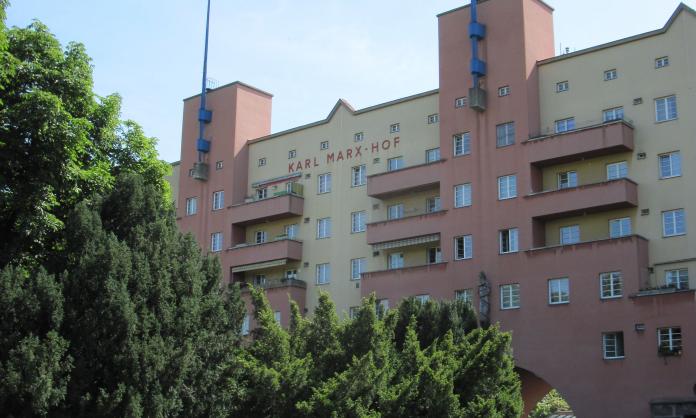Australia is facing a full-blown housing emergency. House prices have been increasing faster than wages for decades, meaning that for many people, the prospect of ever owning a home is now vanishingly remote.
Between 2001 and 2022, the average time required to save for a deposit of 20 percent of a home’s value rose from six to eleven years; the ratio of median housing values to median household incomes went from 4.5 to 8.5. Workers wanting to break into the market are being forced further and further away from inner urban areas where jobs and services are concentrated, into the soulless wastelands of ever expanding sprawl.
Many have given up altogether. At the time of the last census in 2021, 66 percent of households owned a house—31 percent outright and 35 percent with a mortgage. This figure has been in steady decline for the past 30 years, falling from 71 percent—with 42 percent outright ownership—in 1994. Conversely, the proportion of renters has been rising. In 1994, 18 percent of households rented from a private landlord; today, it’s 26 percent. For increasing numbers, renting, with all the associated uncertainties, is now a lifelong prospect.
It’s unsurprising, in this context, that more and more people are being forced onto rapidly growing waiting lists for public housing, or are joining the ranks of the homeless. According to the Australian Bureau of Statistics, the number of people “experiencing homelessness” grew from 89,733 in 2006 to 122,494 in 2021.
The solutions to this crisis offered by the Labor Party—currently in power federally and in every state and territory except Tasmania—are laughably inadequate. Federal Labor’s proposed $10 billion “housing future fund” promises the construction of just 30,000 new “social and affordable” homes over five years. As of 2021, the last year for which data is available, there were 163,500 households on waiting lists for public housing.
The Victorian state government has made much of the $5.3 billion “big housing build” that it announced in 2020. This promises the construction of just 12,000 new dwellings over four years, only 9,300 of which will be social housing. The way things are going, it’s doubtful that even this meagre target will be met. As of 30 June 2022, according to the government’s own figures, there were 86,887 social housing units across Victoria, an increase of just 74 from four years earlier. Over the same period, the housing waiting list grew by more than 20,000, from 44,000 to 64,168.
The crisis is set to deepen further in coming years. Capitalism is supposed to be a system in which “supply and demand” come to a natural balance. This isn’t what’s happening with housing. Today, at exactly the moment when demand for new housing is at a peak, supply is collapsing. Astonishingly, considering how the system is supposed to work, 2023 is set to be a record year, not for builders “making bank”, but for builders going bankrupt.
The reasons are complex. Rising interest rates are a factor. So too is the spike in the price of building materials. But underlying it all is the irrational and chaotic nature of the housing market, in which a mess of banks, landholders, developers, investors and builders are all competing to secure for themselves the biggest possible share of the profit squeezed from people seeking to satisfy the basic human need for shelter.
Nothing about this is normal. The fact that it may appear that way—as if the failure of this system to deliver something so essential as housing is akin to a natural disaster over which we have little or no control—reflects the success of the capitalist class and their servants in parliament in presenting their “free market” ideology as political common sense.
In a socialist society, where production would be geared towards human need, rather than profit, the housing crisis could be solved easily and relatively quickly.
Were economic priorities democratically decided by the mass of workers and the poor, it’s highly unlikely that, for instance, we’d continue to allow so many houses—more than 1 million, according to the 2021 Census—to sit empty for extended periods of time. Nor, when many are struggling to keep a roof over their head, would we still be building luxury apartments for the rich, or shopping malls, casinos, expensive sports stadiums, nuclear submarines and other such things.
Under socialism, society’s resources, both natural and human, would be channelled towards the rapid production of millions of new, high-quality housing units, as well as the community infrastructure and services, public transport options, parkland and so on required to make new developments livable.
These wouldn’t all have to be built in “greenfields” sites in the outer suburbs either. In the absence of the kind of incentives that encourage owners of inner urban properties to hold onto their land at all cost and vehemently oppose even modest changes to the surrounding urban landscape, a significant amount of space could be found in these areas for new medium-density residential development.
If you doubt that workers, given the chance, would prioritise things in this way, consider the example of the Builders Labourers Federation’s (BLF) “green bans” in the early 1970s. In January 1972, NSW BLF Secretary Jack Mundey explained it this way:
“Yes, we want to build. However, we prefer to build urgently required hospitals, schools, other public utilities, high-quality flats, units, and houses, provided they are designed with adequate concern for the environment ... Though we want all our members employed, we will not just become robots directed by developer-builders who value the dollar at the expense of the environment.”
It’s true, of course, that we can’t “wait for revolution” to solve the housing crisis. Even under capitalism, though, there is much that could be done, if only governments were prepared to intervene directly and forcefully into the sacrosanct “functioning” of the capitalist market. Today, they are unwilling to do so. There have been times in the history of capitalism, however, when they have.
One example is from Vienna, Austria, during the decades between the two World Wars. After World War One, the whole of Europe was swept by a wave of revolt, starting with the revolution in Russia in 1917 and spreading west. Austria was no exception. As in Germany, the revolutionary tumult of 1918 and 1919 brought the social democrats (reformist socialists) to power, and in “red Vienna”—the main centre of the Austrian working class—they ruled continuously from 1919 to 1934.
In an effort to tame the revolutionary workers’ movement and restabilise society, the city government embarked on an ambitious program of reform. Central to this was the construction of 61,175 new public housing units across 42 major developments.
These weren’t the kind of drab tower blocks built in Australian cities by the Menzies government in the 1950s and ’60s. Rather, as Meagan Day writes in an article for Jacobin, “they were high-concept, masterfully-built edifices ... [which] featured leafy courtyards, copious open space, and plenty of natural light. They had well-equipped shared laundries and communal state-of-the-art kitchen facilities. They were connected to, and sometimes contained within them, public schools and cooperative stores. Many even had bathhouses and swimming pools, healthcare and childcare centers, pharmacies, post offices, and libraries on the premises”.
Go to Vienna today, and you’ll see that these “masterful edifices” still stand, and that the working-class communities that live in them continue to enjoy a standard of living that Australian public housing tenants could only dream of.
Those 61,175 housing units might not seem like much, but you have to consider them in light of the relatively small population of Vienna at the time. In 1930, it was 1.8 million. Were an equivalent number of new housing units built in Melbourne today (population 5 million) the figure would be more than 160,000. An equivalent housing build across Australia (population 26 million) would deliver around 850,000 new housing units.
You also have to consider that Australia and other Western countries are today vastly richer and more productive than Austria was in the 1920s and 1930s.
To get a genuine sense of the significance of what they did, you really have to multiply the equivalent per capita delivery of housing units even further. You’d think it wouldn’t be too much of a stretch to double it, and build 1.7 million new housing units across Australia over the next decade and a half.
That would cost a lot of money. Assuming $300,000 per unit (which is on the high end of cost estimates detailed in a recent report by the Grattan Institute) it would come to around $500 billion. Consider, though, that Labor’s planned Stage 3 tax cuts are now forecast to cost $313 billion over 10 years. Ditch those, and you’ve got $470 billion over 15 years right there. Cut the hundreds of billions slated to be spent on nuclear submarines under the AUKUS deal too and you’ve got your $500 billion with ample to spare.
It can be done. The fact that what we’re being offered instead by Australia’s Labor governments amounts to a few small crumbs, reflects the reality that they’re under very little pressure to do otherwise. Under the “business as usual” of capitalism, governments act, as Marx put it in the Communist Manifesto, as “a committee for managing the common affairs of the whole bourgeoisie”. And from the perspective of the capitalist class in Australia, the condition of the housing market is, on the whole, very much a good news story.
The market continues to deliver ever greater wealth to those at the top. The forecast shortfall of housing over coming years will reinforce this. And it’s not just big banks, developers, property investors and others with a direct stake in the housing market that stand to benefit. The kind of crippling interest rate rises and rent increases we’re seeing are likely, in the absence of any serious fight from the unions, to make for a more pliant workforce too.
The loyal servants of capital in the Labor Party will be only too happy to let these “good times” roll. If wanting to see their ruling-class mates do well wasn’t enough, consider too that the current crop of Labor MPs own, according to data compiled by Crikey, an average of 2.3 properties each.
If we’re to win more than the scraps they’re offering, we’ll need to apply the kind of revolutionary hot poker that prompted the social democrats in places like Vienna to enact their “big build” of the 1920s and 1930s. And if we get that far, let’s not repeat the mistake made by workers in Austria back then of satisfying ourselves with a few reforms. Let’s rid ourselves of the inhuman irrationality of the capitalist market in housing, and everything else, for good.









